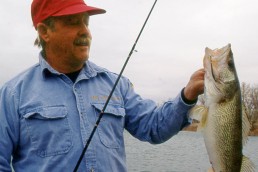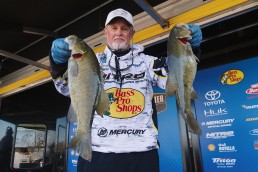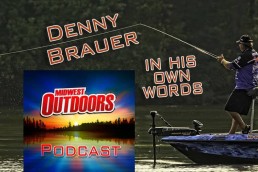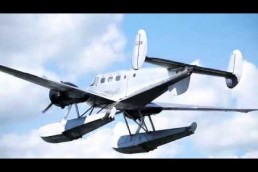Mike McClelland in his own words
SHARE THIS POST
Exclusive MidWest Outdoors Interview with professional walleye angler: Mike McCelland.
Still Humble After all These Years
Few anglers have had as significant an impact on their sport as Hall of Famer Mike McClelland, whose name is synonymous with competitive walleye fishing. Throughout his long career, he’s also been an author, seminar presenter, tackle designer and promoter, guide, businessman, boat rocker and wave maker who dared to start new ventures and try new things.
Those privileged to call him friend also know there’s a gentle sense of humor lurking behind those sparkling eyes and that wily grin, just begging to come out at a moment’s notice. All told, he’s definitely someone that anyone would love to spend a day in the boat with. Barring that, the next best thing is having the chance to visit with him here, where he shares his thoughts on fishing, friendships and family.
MidWest Outdoors: Mike, it was funny that, as we prepared to begin this interview, we both remembered how we used to meet on Sunday nights in the Minneapolis Airport on our ways back from doing weekend seminars all over the country.
Mike McClelland: Always on the last flight out. Man, we put on a lot of miles.
MWO: You are one of the true pioneers and legends in walleye fishing, not only as an angler and educator, but one of the real forces in bringing competitive walleye fishing to the forefront of the angling world. But before we even get into that, why don’t you tell our readers what led you into fishing, and how you got into the walleye game.
McClelland: I was fortunate enough to have a father who fished, so I got the fishing bug early. Every opportunity I had, I went fishing. But where I grew up in the Council Bluffs area of Iowa, we never had walleyes. It was all catfish and carp, so if you wanted anything else, you had to go on vacation.
So I started going up to Minnesota on family vacations. And when I started working at a lodge at Big Stone Lake during the summers, I learned that walleyes can be in very, very shallow water, which a lot of people had overlooked. I guided at Big Stone and other lakes, and finally found my way over to Pierre, South Dakota, on the Missouri River system, which was an entirely different fishery than what you had in a natural glacial lake. So it was a whole new learning experience again.
Fortunately, in 1982, I ran into some guy named Bob Propst Sr. A yellow pickup drove by with a sign on it that said Bob Propst, Walleye Guide. And I said to my brother, “Who would have gall enough to call themself a walleye guide?” Well, it turned out he was indeed a walleye guide, and I’ve learned so much from him.
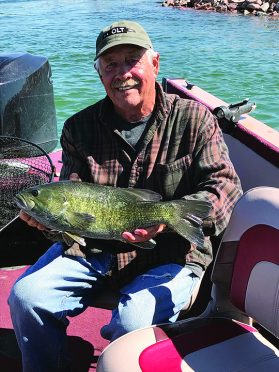
So I spent some time with Bob, and we decided we wanted to get some sponsorships. So we went and got 50 addresses out of every outdoor magazine and manufacturer we could find, and we sent ‘em all a letter, which took about all the money we had just to buy the stamps. Finally, we got a couple of responses. Luhr-Jensen sent us some lures, which was very nice of them. And Zebco sent us a letter saying, “We have real fishermen to do this.”
So basically, we decided that nobody knows us, and we needed to get out and do seminars. Neither one of us had ever done one. So Bob borrowed his mother’s car, a ’61 Ford, because it got good gas mileage. I conned my wife out of what money she had, and headed out through Nebraska, Kansas, Missouri, up through Minnesota and over to North Dakota. We’d just pull into any town, go through the phone book, find any sporting goods store or bait shop, and say this is who we are and what we can do for you. We made all kinds of deals for lodging and advertising, which seldom worked. We went so far as scheduling a seminar on Valentines Day. You don’t want to do that. No guys are gonna come.
MWO: Kind of like fishing a new lake. You pull in, and right or wrong, you try something.
McClelland: We ran out of money several times, but always got someone to send us some more, and we kept plugging away. We finally had a good one in Minot, North Dakota. A tackle store named Harvey Enterprises sponsored us, and we made enough money to get us home.
Along the way, we heard about a new tournament circuit starting up called MWC—which at that time was the Manion’s Walleye Circuit. At that time, it was one tournament, and then going to go into a series or tournaments. So we went and fished that tournament, which was at Castle Rock Flowage in Wisconsin, and I won it, luckily. But the bad luck was, he didn’t have any money to pay me.
MWO: Welcome to the walleye game!
McClelland: Exactly! But anyway, the next year he tried to do another circuit, which didn’t work. It was then taken over by the Manufacturers’ Walleye Council—still MWC. Bob and I wondered how we’d stack up against all these other guys from Minnesota and Wisconsin, Illinois and Ohio. So we got the money together, and that lit up a whole world for me. There were all these other people with all these new techniques, and at that time, everybody shared. The discovery was what made MWC and the tournament circuits so special.
MWO: Later you went on to fish Professional Walleye Trail (PWT) tournaments, where you did very well. You were always one we looked for when we did camera coverage, because you were always a threat to win.
McClelland: It was constant learning. You’d get one little bit of information, and it would run through your brain like a computer.
MWO: Sometimes I’d see things I didn’t expect. Like the time Bob Propst Sr. showed up to fish Lake Erie in a pontoon boat. We were all concerned for safety, but he said, “Don’t worry. The waves wash through and clean the deck off. The fence keeps all the tackle boxes and people inside.”
Another time I saw him at Lake Winnebago. I could just see the top of his head. He was wearing this great big straw hat, in the middle of a cane field. Whoever thought about fishing for walleyes in 3 feet of water?
McClelland: If that’s where the fish are, that’s where you fish for them.
MWO: I also remember that you used to say the camera boat was bad luck. We’d pull up to film, and you’d say, “That’s it. The bite just died,” and then take off for another part of the lake.
Are you enjoying this post?
You can be among the first to get the latest info on where to go, what to use and how to use it!
McClelland: Yeah, but when I caught a good fish, I’d say, “Where the heck is that camera boat now?”
MWO: As the sport developed, and things got more complex, or we made it more complex in our coverage, you always focused on keeping things simple and straightforward, and most importantly being efficient in your presentations.
McClelland: We spent so much time trying to get walleyes to bite, using everything from fish scents to changing colors, or how we were jigging. But you know, I always fished a lot of shallow water, and watched fish bite. I’d watch a walleye come up to a jig, flare its gills—you’d see the white flash—and the jig disappears. They don’t bite anything. They suck it in with the flow of water. What we had to figure out was how to allow that fish to eat; how to suck it in with the flow of water.
A good example, if you watch fish strike, you’ll see them hit as many times when the jig is moving up as when it’s falling down, although you’ll never catch one on the stroke up. You pull it out of the flow of water into the fish’s mouth. But when the jig is falling, there’s slack in the line. Now when he sucks the water in, it can go.
This falls into all my presentations. The correct way to use a bottom bouncer is with a skip and pause. Put the rod in a rod holder, and it’ll outfish someone holding the rod. You have to have your line going into the water at a 45-degree angle. More than that, and the whole bouncer lies down. Less than that, and the whole bouncer just comes through the water. You want it so the wire just touches. The top rocks forward, and then the whole thing lifts, kicks forward and then settles back to bottom. So you always get a good pause that allows the fish to suck in your bait.
The same way when I fish my crankbaits. I would never do just a direct troll. It always was stop and go. Stop, and that’s when you get the hit.
With a Lindy Rig, lift it up, set it down, to get slack in the leader. I’d strip line off a spinning reel, which was coiled with memory, to make my leaders. The slack would allow fish to inhale the bait better than a straight leader.
MWO: I recall a PWT Lake Erie tournament that you won where you were using spinners and crawlers in open water, trolling along and then stopping, letting those spinners flutter down.
McClelland: I’d do that if I didn’t have good waves. With waves, longer rods load and unload, giving you that slack that allows fish to bite. Go with the waves, you surge and pause, and you catch fish. Go against the waves, and you don’t catch fish. You’re under power at a steady speed. You don’t get the stop-and-go.
After you go through a suspended school of fish, you go back upwind, and come back through them. That all falls under allowing fish to eat. That’s always my priority, and where I start. After awhile, I might really get wild and change colors [chuckles]. But not very often!
MWO: Before we go, share with our readers how important it is that, to make it in this business, you don’t just get to fish all the time. You have to put in a lot of hard work.
McClelland: I can’t express enough that education is important. I have a degree in marketing. Without that education, I would have still thought that people are going to pay me to catch fish [chuckles]. They ain’t gonna pay you a dime to catch fish! That will give you a platform to get an audience. But you have to sell product and new ideas to that audience. Work with good companies and products, and you can promote them naturally. Products have to be bought and sold. That’s how the whole thing works.
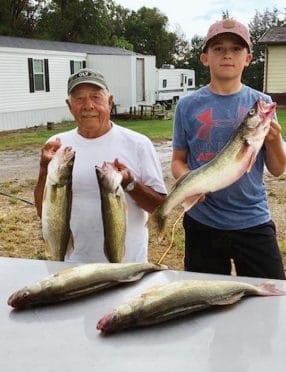
MWO: Do you fish any tournaments anymore?
McClelland: Mostly, I like to fish with my grandson, and we fish ‘em all the time. We do everything from trout fishing to paddlefishing to catching bluegills.
Want more hints and humor from Mike McClelland?
Enjoy the rest of the story on our podcast, with Mike McClelland describing how he won two consecutive Mercury National Tournaments, largely because no one would believe how shallow he fished the first time. The importance of unconditional support from your spouse and family. And lastly, a hilarious array of Bob Propst Sr. stories, along with a fond remembrance and tribute to his lifelong friend and mentor. It’s all in the Podcast section at MidWestOutdoors.com.
McClelland through the years
1950s-70s: Grows up in Council Bluffs, Iowa, fishing and guiding in southeastern Minnesota. Abandons a career building houses during a period of high interest rates and focuses on guiding.
1982: Meets and strikes up a lifelong friendship with mentor Bob Propst Sr.
1983: Hits the road doing seminars with Propst.
1983: Fishes and wins inaugural MWC tournament at Castle Rock Flowage, Wis.
1989: Begins fishing Professional Walleye Trail tournaments.
1997: Helps spearhead formation of National Professional Anglers Association (NPAA).
1993: Propst and McClelland elected to National Fresh Water Fishing Hall of Fame.
2018: Fishes the occasional tournament. Mostly fishes with his grandsons.
MWO
SHARE THIS POST
Did you enjoy this post?
You can be among the first to get the latest info on where to go, what to use and how to use it!
Dave Csanda
Dave Csanda has enjoyed 40 years in the fishing communications industry at In-Fisherman, Angling Edge and now, as editor of MidWest Outdoors. He is an inductee of both the Minnesota and National Fresh Water Fishing Halls of Fame.
